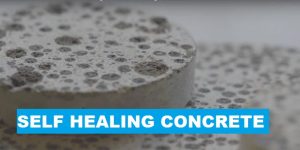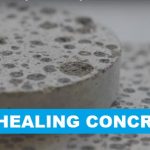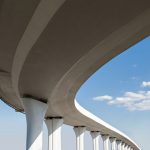Ferrocement is a type of thin reinforced concrete construction, mostly used for aesthetic purposes, but not always. The term ferrocement comes from the combination of two words, which is ferro and cement. Ferro means steel/iron and cement means bind/glue. So technically ferrocement means bind-the-iron-together.
The advantage of this technology is that it is very flexible and can be used to create any shape and form of structure. The cement mortar mix is reinforced with layers of steel wire mesh (which is also known as chicken wire mesh). The mesh is used to act as a tensile stress absorber, as well as to provide ductility and stability to the ferrocement structure.
The cement mortar mix is mainly providing the mass to the structure. The ferrocement also exhibits remarkably high tensile strength-to-weight ratio and superior cracking resistance behavior.
There are also many reported evidence of ferrocement being capable of improving many other engineering properties, such as toughness, fatigue resistance, permeability, etc.
For some specific applications, where higher tensile resistance is expected, steel bar would be used to form the structure.
The Material for Ferrocement Mix
Ferrocement mix is made of very-rich cement-mortar matrix, which consists of ordinary Portland cement (OPC) and fine aggregate. The type of cement to be used is depends on the service conditions. As for any type of concrete, the cement shall be in good quality. The cement shall be stored in dry conditions, and the stock shall be as new as possible.
The fine sand used, which is about 60 to 75 percent of the total ferrocement mix, shall be also in good quality. Typically, the sand shall be hard, strong, non-porous, debris free, free from silt, clay, and other organic impurities. The sand also should not be too fine, which will require more water to achieve the required work-ability, and this would affect the strength and permeability.
Recommended size range for the sand is between 2.36 mm and 1.18 mm. Apart from these two main ingredients, mixing water is also plays an important role in affecting the properties of the ferrocement mix. The water used shall be at the same quality as drinking water.
Admixtures for Ferrocement Making
To improve the performance of the concrete mix, some form of chemical admixtures could be used. Some of the common reason to use chemicals admixtures is to
- improve the work-ability,
- water reduction to increase the strength and reduce the permeability,
- water proofing,
- improve the durability,
- to avoid corrosion of wire mesh.
Besides chemical admixture, natural admixtures also could be used to improve the durability of ferrocement concrete; and the most common natural admixtures are fly ash (PFA), slag (GGBFS), palm oil ash (POFA), etc.
Tensile and Crack Properties of Ferrocement Mix
The engineering properties of ferrocement structure are equivalent to normal concrete, and in some applications, it is even superior to normal concrete. The tensile strength of ferrocement is a result of the volume of reinforcement used in the structure. Apart from the volume of reinforcement, the direction of its use in line with the force direction and tensile stress direction is also important.
The tensile performance of the ferrocement concrete or structure can be grouped into three, namely, the pre-cracking phase, post cracking phase, and finally the post yielding phase.
A ferrocement member subjected to upwards tensile stress behaves something like linear elastic material until the first crack appears. Beyond this, the member will enter the multiple cracking and eventually continuing to a point where the mesh starts to experience yielding. Once at this stage the number of cracks will continue to grow with the increase in the tensile force or stress.
The specific surface area of the ferrocement member or element has been found to influence the first crack in tension, as well as the width of the cracks. The maximum stress at first crack for ferrocement matrix increases in proportion to the specific area of the element. The behaviour of ferrocement element under compression is mainly depends on the mix design properties.
The well distributed and aligned reinforcement has made the ferrocement to behave like steel plates. Ferrocement is also has other outstanding properties besides its engineering properties compared with normal concrete.
Advantages and Applications of Ferrocement
Ferrocement exhibits an extremely easy mould-ability characteristic, that it can be used to produce any desired shape of structure. Besides that, due to the superior tensile behaviour and water tightness, the material is widely used for lightweight construction and water-tight structure as well as for portable structures.
Some of other successful applications of ferrocement include boat, sampan, pipes, shell roofs, wind tunnel, modular housing, sandwich panel, swimming pools, permanent forms for concrete structures, etc.
The major advantages of the ferrocement can be summarized as:
- It offers the possibility of producing a very thin and light structures. This means it can give cost saving through the material usage. Apart from the material saving, the overall dead weight of the structure also could be reduced by employing ferrocement; thus, it will result in more economical foundation design.
- It is also very suitable for pre-cast concrete industries, which results in easy and cheaper transportation.
- It is possible to reduce the dependency on skill labor. This is mainly due to the fact the ferrocement application is quite simple and easy.
- In some construction activities the use of ferrocement could reduce (or eliminate in some cases) the use of form-work. The ferrocement members can act as permanent form-work.
Benefits of Using Ferrocement for Boat Building
Adapting proper techniques and guidelines, the following benefits can be materialized using ferrocement as boat building materials.
- Cost effectiveness – almost in all developed or developing countries the cost of ferrocement is much cheaper compared to wooden sampanor boats. This is because wood always has better price when used to make furniture compared to boats. Therefore, it is very discouraging to use wood to make boats/sampan, and most of the time ferrocement becomes the material of choice.
- Less environmental problem – as part sustainable initiatives, many countries has minimized (even stopped) logging activities in large scales. There are many environmental guidelines to be followed. However, with ferrocement, this is not an issue at all.
- Ease of making – ferrocement boats is quite easy to make without having to use any heavy machinery. Most of the work for making the boats can be made using ordinary building tools.
- Raw material – The raw material needed for making ferrocement is also easily available in most countries. On the other hand, the wood is not easy material to obtain. This is because not all type of wood can be used to make boats; therefore, finding a particular type of wood is not easy.
- Less skilled labor – compared to woodworking labors, the ferrocement boat maker is far less skilled. Anyone can learn the tricks immediately and apply it. Woodworking labors are needed to be highly skilled, which also will result in much higher labor cost.
- Better durability – the durability of ferrocement is same as any concrete material. It does not corrode, spall, or rot, provided it is done properly. In general, the ferrocement boat does not require any major maintenance.
- Strength – there are no other materials that can perform like ferrocement when it comes to its strength. Since ferrocement is a form of concrete, its strength will continue to develop over time, and this means the structural integrity of the boats also increases with the age.
- Ease of maintenance – any structure will require some maintenance over time due to wear and tear, and ferrocement boats are not an exception as well. The ferrocement boats may suffer some damages due to collision or impacts while in service; therefore, requiring some maintenance and this can be done easily without using any special technique or equipment’s. The affected area can be repaired with new mix of ferrocement using the same technique used to build the boat at the first place.










